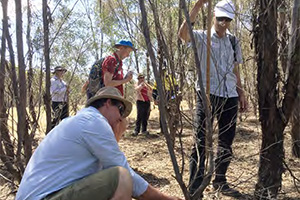Sustainability
- Home
- Locations
- What you can do
- LiFE Framework
- Sustainable Development Goals
- About us
- Grants
- Events
- Contact us
Now searching for:

Field measurements being taken at one of CO2 Australia’s revegetation sites that forms part of our carbon offset portfolio.
Charles Sturt’s Greenhouse Gas Emissions (GHGE) for the 2021 calendar year were 36,474 tonnes of carbon dioxide equivalent. This is a reduction of 16 per cent compared to our 2014 base year. The 2021 emissions reduction performance as per the previous year, was significantly impacted by reduced campus activity and staff travel due to the COVID pandemic.
Charles Sturt buys and retires offsets equivalent to its organisational carbon footprint as part of its commitment to being a certified carbon neutral organisation under the Climate Active program. The requirements of carbon neutral certification go significantly beyond simply offsetting GHGE. It requires a demonstrated strategy, programs, effective reductions in GHGE, and improvements in energy efficiency.
In 2021, 78 per cent of our GHGE were attributable to electricity and gas emissions. We completed a procurement activity in 2021 focused on reducing our forward electricity emissions via renewable energy. The result of this has been the awarding of the contract with Iberdrola Australia, a renewable energy company, for supplying renewable wind electricity from its wind farm near Wellington, commencing from January 2022.
Our 2021 carbon offset portfolio was made up of four offset projects, comprising renewable energy projects in China and India in addition to the following Australian-based projects:
Greenhouse gases emitted from savanna fires make up three per cent of Australia’s total emissions. Savanna burning projects undertaken by Traditional Owners and First Nations rangers reduce GHGE by undertaking cool, lower intensity fires in the early dry season when the vegetation still contains moisture from the wet season. This reduces the GHG emitted from high intensity, unmanaged fire in the late dry season when the country is dry.
In addition to the carbon abatement, the project is delivering ‘core benefits’ to the country, including a range of social and environmental benefits.
This project establishes permanent plantings of eucalyptus trees on land previously used for agricultural purposes. Benefits include increased on-farm biodiversity and new, diversified sources of farm-generated income.
The project is in the local government areas of Bland, Carrathool, Coolamon, Dubbo, Greater Hume Shire, Lachlan, Narrandera, Narromine, Parkes and Wellington.